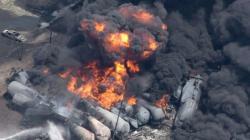Railroad Workers United: Statement Upon the Acquittal of Canadian Railroad Workers
Railroad workers – together with all citizens concerned with worker justice – across the continent are celebrating the acquittal of Canadian railroaders who were wrongly accused by the Crown for the tragedy at Lac-Mégantic in which 47 people were killed when a long and heavy oil train crashed and exploded in the middle of that small town in July of 2013.
At the time of the wreck, Railroad Workers United (RWU) had spoken out quickly, releasing a statement within a week condemning the reckless practices on the rail carrier – the Montreal, Maine and Atlantic (MM&A) – and its renegade CEO Ed Burkhart. Since then, RWU has defended the railroad workers, denying that they in any way should be charged with a criminal offense, demanding that the charges be dropped, and that the Crown charge the real criminals – the MM&A bosses and the government regulators who had turned a blind eye to their irresponsible actions regarding safety.
Once the workers were arrested, RWU took part in protest actions, assisted with organizing a defence committee, began raising funds for the defence, and attempted to raise awareness of the issue on both sides of the border. Despite the overwhelming evidence of company recklessness and irresponsibility, the Crown refused to drop the charges, and proceeded onward to the trial which finally commenced – more than four years after the event – in September 2017.
While the prosecution focused largely on a single event – the alleged failure of the locomotive engineer to tie enough handbrakes, they were tripped up at every turn by their own witnesses – government, company, “expert” and otherwise – who, by their testimony, incriminated the company and the government regulators rather than the defendants.
Some of the highlights that were revealed at the trial include:
1 – The implementation of single employee train crews just months earlier, had played a key role in the wreck. One other railroad that had been operating trains in this fashion for years (QNSL) had provided 10 days of training and made 69 safety accommodations prior to the implementation of such operations. The MM&A did none of these, while the government stood idly by. After the wreck however, Transport Canada outlawed the further implementation of the practice.
2 – The MM&A had allocated practically no funding for safety or emergency training, nor standardization of rules compliance, and had a terrible safety record compared to most rail carriers.
3 – The train in question was thousands of tons over limit. Significantly, the company had no set policy for the number of handbrakes that were necessary to secure such trains. That number remains in question, but experts now agree that the number for such a train on such a grade is well more than had been considered at the time.
4 – The train – by company policy – was left unattended on the mainline on a steep grade with no derail or other means of protection against runaway.
5 – The train’s lead locomotive was defective, and ultimately this fact would catalyse the runaway. Despite awareness of this fact, the company had failed to make necessary repairs to it, nor utilize it as a trailing unit in the consist. In addition, the mainline trackage was in a dilapidated state because of deferred maintenance by the carrier.
6 – Company policy was to leave the train’s automatic brake in the release position, even though the generally accepted practice by railroad policy and law is to leave unattended trains with the automatic brake in the “full-service” (fully applied) position. Every car of the train could have had its air brakes fully applied, but the company – against general rule and wisdom of a hundred years – insisted that engineers not set the air brakes on the train when leaving the train alone. Had this reckless and bizarre policy not been insisted upon by MM&A, the train almost certainly could not have rolled away.
All told over the course of four months, the jury gained a picture of a railroad company that was oblivious to safety concerns, one far more interested in making money than in the safety of its workers or trackside communities. While RWU applauds the jury’s verdict and sees the acquittal as a victory – not just for the MM&A railroad workers but for all railroad workers – we must remain vigilant. Railroad carriers in the U.S., Canada and elsewhere are intent on criminalizing employees, pointing the finger at them when something goes wrong, as a means of deflecting attention away from their own failures, whether it be inadequate training, lack of qualifying time, chronic crew fatigue, deferred maintenance, dangerously long and heavy trains, inadequate staffing and more. Railroad workers must be ready, willing and able to come to one another’s defence to prevent the rail carriers and the state from criminalizing our behaviour while they – the real criminals – get off Scott free.
Railroad Workers United
Solidarity — Unity — Democracy
January 21, 2018.
This was a press release from the Railroad Workers of Canada.
For more information Contact: Ron Kaminkow, RWU General Secretary
email: secretary@railroadworkersunited.org



